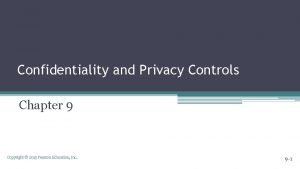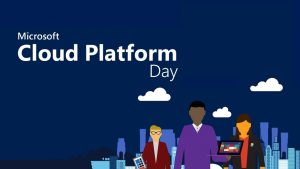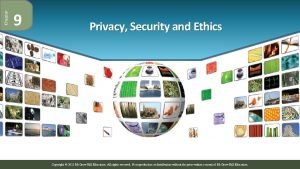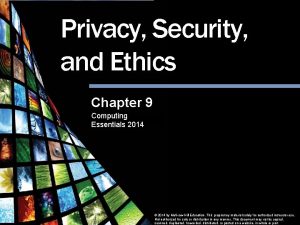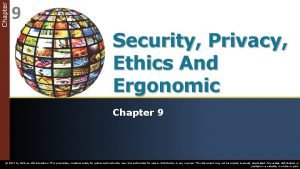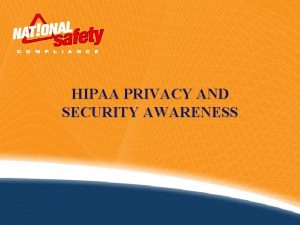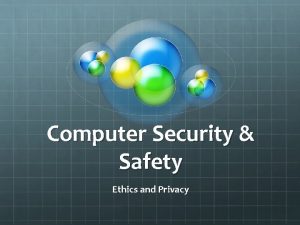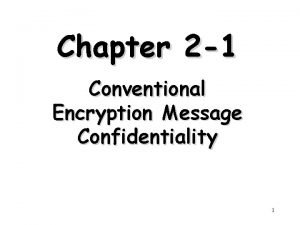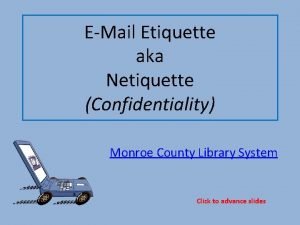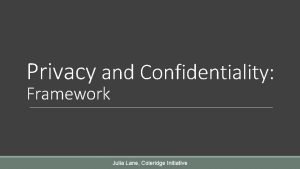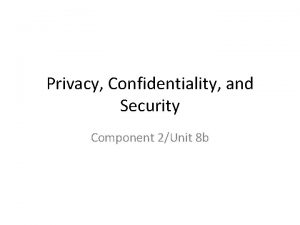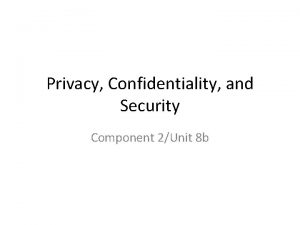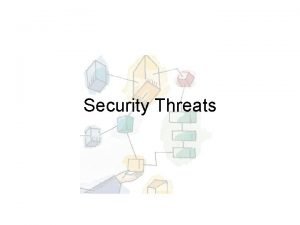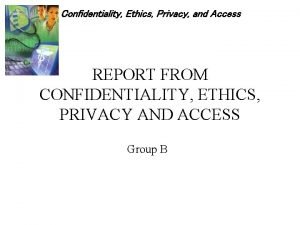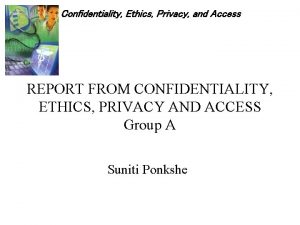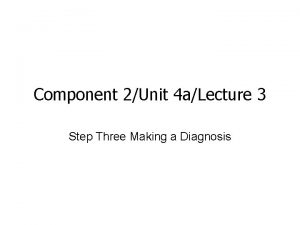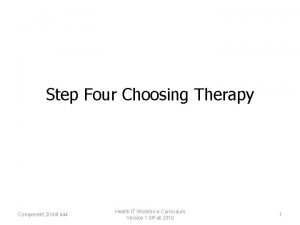Privacy Confidentiality and Security Component 2Unit 8 c











- Slides: 11

Privacy, Confidentiality, and Security Component 2/Unit 8 c

Tools for protecting health information • IOM report: For the Record (1997) • Report commissioned by NLM; informed HIPAA legistation • Looked at current practices at six institutions • Recommended immediate and future best practices • Some content dated, but framework not Component 2/Unit 8 c Health IT Workforce Curriculum Version 1. 0/Fall 2010 2

Threats to security • Insider – Accidental disclosure – Curiosity – Subornation • Secondary use settings • Outside institution – A lot of press, few examples Component 2/Unit 8 c Health IT Workforce Curriculum Version 1. 0/Fall 2010 3

Technologies to secure information • Deterrents • Obstacles – Alerts – Audit trails • System management precautions – Software management – Analysis of vulnerability Component 2/Unit 8 c – – – – Authentication Authorization Integrity management Digital signatures Encryption Firewalls Rights management Health IT Workforce Curriculum Version 1. 0/Fall 2010 4

Encryption • Necessary but not sufficient to ensure security • Should, however, be used for all communications over public networks, e. g. , the Internet • Information is scrambled and unscrambled using a key • Types: symmetric vs. asymmetric – Asymmetric, aka public key encryption, can be used for digital certificates, electronic signatures, etc. Component 2/Unit 8 c Health IT Workforce Curriculum Version 1. 0/Fall 2010 5

Standards for encryption and related functions • Advanced Encryption Standard (AES) – NIST-designated standard for encryption/decryption (Daemen, 2002) • Transport Layer Security (TLS) and predecessor, Secure Sockets Layer (SSL) – cryptographic protocols that provide security for communications over all points on networks (Rescorla, 2001) • Internet Protocol Security (IPsec) – protocol for securing Internet Protocol (IP) communications by authenticating and encrypting each IP packet of a data stream – Part of IPv 6 but also added as standalone on top of IPv 4 • Secure Hash Algorithm (SHA) protocols insure integrity of transmitted information and documents (NIST, 2002) – Security flaws have been identified in SHA-1 so SHA-2 family of protocols has been developed • For more: Wikipedia and – http: //csrc. nist. gov/groups/ST/toolkit/ Component 2/Unit 8 c Health IT Workforce Curriculum Version 1. 0/Fall 2010 6

NRC report best practices • Technical • Organizational – Confidentiality and security policies and committees – Education and training programs – Sanctions – Patient access to audit trails Component 2/Unit 8 c – Authentication of users – Audit trails – Physical security and disaster recovery – Protection of remote access points and external communications – Software discipline – Ongoing system vulnerability assessment Health IT Workforce Curriculum Version 1. 0/Fall 2010 7

Authentication and passwords • Authentication is process of gaining access to secure computer • Usual approach is passwords (“what you know”), but secure systems may add physical entities (“what you have”), e. g. , – Biometric devices – physical characteristic, e. g. , thumbprint – Physical devices – smart card or some other physical “key” • Ideal password is one you can remember but no one else can guess • Typical Internet user interacts with many sites for which he/she must use password – Many clamor for “single sign-on, ” especially in healthcare, where users authenticate just once (Pabrai, 2008) Component 2/Unit 8 c Health IT Workforce Curriculum Version 1. 0/Fall 2010 8

Some challenges with passwords • Common approach to security is password “aging” (i. e. , expiration), which is less effective than other measures (Wagner, 2005) – Session-locking – one or small number of simultaneous logons – Login failure lockout – after 3 -5 attempts • Password aging may also induce counterproductive behavior (Allan, 2005) Component 2/Unit 8 c Health IT Workforce Curriculum Version 1. 0/Fall 2010 9

Health information security is probably a trade-off No security - Web pages Total security - CIA, NSA Where is the happy medium for healthcare? Component 2/Unit 8 c Health IT Workforce Curriculum Version 1. 0/Fall 2010 10

Other issues about privacy and confidentiality to ponder… • Who owns information? • How is informed consent implemented? • When does public good exceed personal privacy? – e. g. , public health, research, law enforcement • What conflicts are there with business interests? • How do we let individuals “opt out” of systems? – What are the costs? When do we override? Component 2/Unit 8 c Health IT Workforce Curriculum Version 1. 0/Fall 2010 11
 Confidentiality and privacy controls
Confidentiality and privacy controls Privacy awareness and hipaa privacy training cvs answers
Privacy awareness and hipaa privacy training cvs answers Microsoft from back doors patch gov
Microsoft from back doors patch gov Chapter 9 privacy security and ethics
Chapter 9 privacy security and ethics Chapter 9 privacy security and ethics
Chapter 9 privacy security and ethics Chapter 9 privacy security and ethics
Chapter 9 privacy security and ethics Hipaa privacy and security awareness training
Hipaa privacy and security awareness training Destructive event or prank a virus was created to deliver
Destructive event or prank a virus was created to deliver Privat security
Privat security Conventional encryption and message confidentiality
Conventional encryption and message confidentiality Bcc trolling email
Bcc trolling email Julia lane coleridge
Julia lane coleridge
